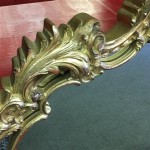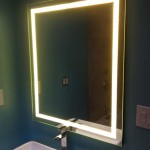Understanding One-Way Mirrors: Functionality, Applications, and Considerations
One-way mirrors, also known as two-way mirrors or observation mirrors, are optical devices that appear as a standard mirror from one side but act as a window when viewed from the other. This seemingly contradictory behavior stems from a precise balance between reflection and transmission of light, achieved through careful manufacturing processes. Understanding how these mirrors function requires delving into the principles of light interaction with differing materials.
The fundamental principle behind a one-way mirror lies in the difference in illumination between the two spaces it separates. The "mirror" side is brightly lit, while the observation side is kept significantly darker. This difference in light intensity allows the reflected light from the brighter side to overwhelm the transmitted light from the darker side, creating the illusion of a mirror. Conversely, from the darker side, the relatively small amount of light reflected is easily overcome by the light transmitted from the brighter side, making it appear transparent.
The construction of a one-way mirror typically involves coating a transparent substrate, usually glass, with a thin, semi-transparent layer of metal. This metallic layer is often composed of aluminum or silver, applied through processes like vacuum deposition or sputtering. The key is to make the metallic layer thin enough to allow some light to pass through while still reflecting a significant portion of it. The level of reflectivity and transmissivity is carefully controlled during manufacturing to achieve the desired one-way effect.
It is crucial to understand that a one-way mirror is not a perfect one-way device. It inherently allows some light to pass through in both directions. The effectiveness of the one-way effect depends heavily on the light differential between the two sides. If both sides are equally illuminated, the "mirror" effect diminishes, and the glass will appear more like a lightly tinted window from both perspectives. The difference in luminance needs to be substantial for the one-way effect to be convincing.
Key Point 1: The Critical Role of Light Differential
The success of a one-way mirror hinges primarily on maintaining a significant difference in light intensity between the observation side and the mirrored side. The mirrored side should be brightly lit, ideally several times brighter than the observation side. This difference ensures that the light reflected from the brighter side overpowers the light transmitted from the darker side, creating the illusion of a mirror. If the observation side is too bright, the transmitted light will become more visible from the mirrored side, reducing the one-way effect and potentially revealing the observers behind the mirror.
To achieve optimal results, it is common practice to use dim lighting on the observation side. This can be accomplished through the use of low-wattage bulbs, strategically placed lighting fixtures, or even simply relying on ambient light from external sources. Additionally, the color of the walls and surfaces on the observation side can play a role; darker colors tend to absorb more light, further enhancing the light differential and improving the one-way effect. The brighter side typically utilizes standard lighting levels, often with a focus on illuminating the area being observed.
The specific degree of light differential required will depend on the properties of the particular one-way mirror being used. Different mirrors have different levels of reflectivity and transmissivity, which will influence the optimal lighting conditions. It is advisable to consult the manufacturer's specifications for the mirror to determine the recommended light differential for the best performance. Failure to maintain an adequate light difference can compromise the functionality of the mirror, potentially rendering it ineffective.
Furthermore, external light sources, such as sunlight, can also affect the performance of a one-way mirror. Direct sunlight shining onto the observation side can negate the light differential, making the mirrored side appear more transparent. Careful consideration should be given to the placement of the mirror and the control of external light sources to ensure its effectiveness.
Key Point 2: Applications Across Various Fields
One-way mirrors find diverse applications in various fields due to their unique properties. Law enforcement agencies frequently utilize them in interrogation rooms, allowing investigators to observe suspects without being seen. This can provide valuable insights into a suspect's demeanor and behavior, aiding in the investigation process. The observed individuals are unaware of being watched, reducing self-consciousness and promoting more genuine reactions.
In the retail sector, one-way mirrors are often employed for loss prevention and security. Store personnel can discreetly monitor customers for suspicious activity, helping to deter shoplifting and other forms of theft. This approach allows security personnel to observe without intimidating or alarming customers, creating a more comfortable shopping environment while maintaining a level of security. The presence of one-way mirrors is generally not disclosed to customers within the store to maintain the element of surprise and maximize their effectiveness.
Psychology and research fields also use one-way mirrors for observational studies. Researchers can observe subjects in a controlled environment without influencing their behavior. This allows for the collection of more natural and unbiased data, which is crucial for conducting accurate and reliable research. The subjects are typically unaware of the observation, ensuring their behavior remains unaffected by the presence of researchers. This is especially useful when studying children or individuals with specific behavioral patterns.
Therapeutic settings can benefit from the use of one-way mirrors as well. Therapists can observe patient interactions with family members or other individuals, providing valuable insights into their relationships and communication patterns. This allows therapists to gain a deeper understanding of the dynamics at play and tailor their treatment strategies accordingly. The presence of the therapist is concealed from the individuals being observed, promoting more authentic interactions.
In the entertainment industry, one-way mirrors are often used to create illusions and special effects. They can be incorporated into stage sets, haunted houses, and other attractions to create surprising and engaging experiences for audiences. The ability to see through one side while appearing reflective from the other allows for unique visual effects that can enhance the overall entertainment value.
Residential applications, while less common, also exist. For instance, homeowners might use one-way mirrors in security systems or to create a sense of privacy while still allowing them to see who is outside. These mirrored surfaces can be integrated into doors or windows, providing an added layer of security and privacy.
Key Point 3: Ethical and Legal Considerations
The use of one-way mirrors raises several ethical and legal considerations. The primary concern revolves around the issue of privacy. Individuals being observed through one-way mirrors are often unaware that they are being watched, which can be considered a violation of their privacy. The extent to which such surveillance is ethically acceptable depends on the context, the purpose of the observation, and the individuals' reasonable expectation of privacy.
In many jurisdictions, the use of one-way mirrors is subject to legal regulations. These regulations often stipulate the purposes for which one-way mirrors can be used, the types of locations where they are permitted, and the conditions that must be met to ensure compliance with privacy laws. For example, some laws may require that individuals be informed that they are being observed, even if they are not able to see the observers. Failing to adhere to these regulations can result in legal penalties.
Specific laws regarding one-way mirrors vary considerably from one jurisdiction to another. Some regions may have strict regulations limiting their use to law enforcement and security purposes. Other regions may have more lenient regulations, allowing their use in a wider range of settings, subject to certain conditions. It is imperative to research and comply with all applicable laws and regulations before installing or using a one-way mirror.
Beyond legal considerations, ethical principles also play a significant role in determining the appropriate use of one-way mirrors. Even if the use of a one-way mirror is legally permissible, it may still be ethically questionable if it violates individuals' rights to privacy, dignity, or autonomy. It is important to consider the potential impact of the observation on the individuals being observed and to ensure that their interests are adequately protected.
Transparency and accountability are crucial elements of ethical one-way mirror usage. When possible and appropriate, informing individuals that they may be subject to observation can help to mitigate privacy concerns and foster trust. Additionally, establishing clear protocols for the use of one-way mirrors and ensuring that these protocols are followed can help to prevent abuse and protect individuals' rights.
Ultimately, the responsible use of one-way mirrors requires a careful balancing of legitimate security or observational needs with the fundamental rights and ethical considerations related to individual privacy and autonomy. A thoughtful and informed approach is essential to ensure that these powerful tools are used responsibly and ethically.
The manufacturing process for one-way mirrors continues to evolve, with innovations focusing on improving light transmission ratios, enhancing durability, and reducing manufacturing costs. New materials and coating techniques are being explored to create even more effective and versatile one-way mirror products. This ongoing research aims to expand the applicability and accessibility of these specialized optical devices while addressing ethical and legal concerns relating to privacy.

One Way Mirrors In Healthcare Simulation Helpful Or Hurtful Healthysimulation Com

What Is One Way Glass Used For

One Way Mirror Wikipedia

This Light Bending Cube Of One Way Mirrors Will Really Trip You Out Twistedsifter

One Way See Through Mirror Two Mirrors For Whole China Glass Curtain Wall Made In Com

This Light Bending Cube Of One Way Mirrors Will Really Trip You Out Twistedsifter

One Way Mirrors Reflective Glass

How Does One Way Mirror Work What Types Are There Mirrors Window S
How Do One Way Mirrors Work And What Are Some Real World S For Them Quora

Why You Shouldn T Use One Way Mirrors For Ux Research








